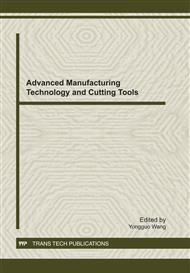p.44
p.48
p.52
p.57
p.62
p.67
p.72
p.76
p.81
Application of Taguchi Method in Vibration Tapping Process
Abstract:
Vibration tapping is capable to tap the deep and small hole in difficult-to-machine materials. Taguchi method is utilized to optimize the parameters in vibration tapping process in order to get the lowest maximum torque. Besides these parameters, this investigation includes the lubrication conditions comprised of dry cutting, conventional flooded lubrication and minimum quantity lubrication (MQL). The results show that the frequency and lubrication condition are significant and interaction effects exist due to these two factors.
Info:
Periodical:
Pages:
62-66
Citation:
Online since:
November 2011
Authors:
Keywords:
Price:
Сopyright:
© 2012 Trans Tech Publications Ltd. All Rights Reserved
Share:
Citation:


